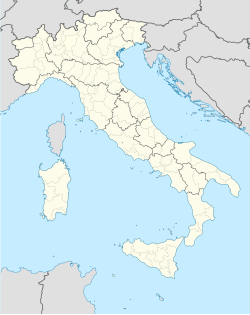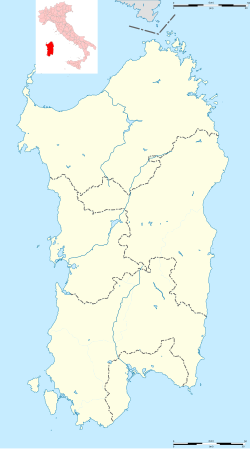Sassari
Sassari | |
|---|---|
| Comune di Sassari | |
 | |
| Coordinates: 40°44′N 08°33′E / 40.733°N 8.550°E | |
| Country | Italy |
| Region | Sardinia |
| Province | Sassari (SS) |
| Frazioni | Bancali, Li Punti, La Landrigga, Caniga, Campanedda |
| Government | |
| • Mayor | Gianfranco Ganau (since May 2005) |
| Area | |
| • Total | 546.08 km2 (210.84 sq mi) |
| Elevation | 225 m (738 ft) |
| Population (December 31, 2007)[2] | |
| • Total | 129,072 |
| • Density | 240/km2 (610/sq mi) |
| Demonym | Sassaresi |
| Time zone | UTC+1 (CET) |
| • Summer (DST) | UTC+2 (CEST) |
| Postal code | 07100 |
| Dialing code | 079 |
| Patron saint | Saint Nicholas |
| Saint day | December 6 |
| Website | www.comune.sassari.it |
Sassari is a city in the region of Sardinia in Italy. It is the capital of the Province of Sassari. About 130,000 people live in Sassari. This makes it the second largest city in Sardinia.
History
[change | change source]The first time that the city appeared in a map was in 1131 with the name Jordi de Sassaro, in 1135 the name was Tathari. The city grown up very fast and in 1294, became a libero comune (independent municipality). In the early 14th century the island of Sardinia was occupied by the Aragonese, the municipality sent a delegation to the court of Aragon, but they did not achieve any agreement. So with the support of the Republic of Genoa and the Doria's family, the people of Sassari rose up against the invaders, until 1417 when the king Alfonso V granted an acceptable status to the town. In 1617 in town the Jesuits founded the University. In 1713, after the Treaty of Utrecht, in the island of Sardinia started the brief period of the Austro-Hungarian administration. In fact since 1720 the island was annexed by the House of Savoy and since then was born the Kingdom of Sardinia. But in 1793, after years of political struggle, in the island started an uprising, called “Sarda rivoluzione” (Sardinian revolution), led by the patriot Giovanni Maria Angioy, who entered triumphantly in the city of Sassari, followed by thousand of revolutionaries coming from all over the island. But the Savoy, stifled the rebellion with ferocity, reconquered the town. But the rebellion in town will continued until the middle of the 19th century. In 1861 the Kingdom of Sardinia, after the campaign to unify Italy and the annexation of many small states, it became the founding state of the new Kingdom of Italy. Since then Sassari is an Italian city.
Museums
[change | change source](Via Roma 64) also called Museo Sanna - SitoArchived 2012-12-16 at the Wayback Machine
Monuments and architectures
[change | change source]- City Walls and pisan-genoan towers, 13th century
- Fontana di Rosello,Rosello Fountain 1585-1606
- Teatro Civico, Civic theatre 1825-1829
- Religious Architectures
- Cattedrale di San Nicola, the Cathedral 12th-18th century
- Chiesa di Santa Maria di Betlem, Church of Holy Mary of Bethlehem 12th-19th century
- Chiesa di San Pietro in Silki, Church of saint Peter in Silki 11th-17th century
- Santa Caterina, Church of saint Catharine 16th century architect Giovanni Maria Bernardoni
- San Donato, 13th-17th century
- San Michele di Plaiano,Church of saint Michael of Plaiano 12th century
- Palaces
- Casa Aragonese, (Aragonese House) 15th century
- Palazzo Ducale, (Ducal Palace) City Hall Building, 1775-1804
- Palazzo Barone d'Usini, piazza Tola, , (The Baron of Usini Palace) City Library, 16th century
- Palazzo Moros y Molinos, 17th century
- Palazzo Ferrale, 16th century
- Palazzo Sciuti, piazza d'Italia, (Sciuti's Palace) the Provincial Legislative Building Provincia di Sassari, 1873

Consulates
[change | change source]Consulates in Sassari:
References
[change | change source]- ↑ "Superficie di Comuni Province e Regioni italiane al 9 ottobre 2011". Italian National Institute of Statistics. Retrieved 16 March 2019.
- ↑ "Popolazione Residente al 1° Gennaio 2018". Italian National Institute of Statistics. Retrieved 16 March 2019.
}}





